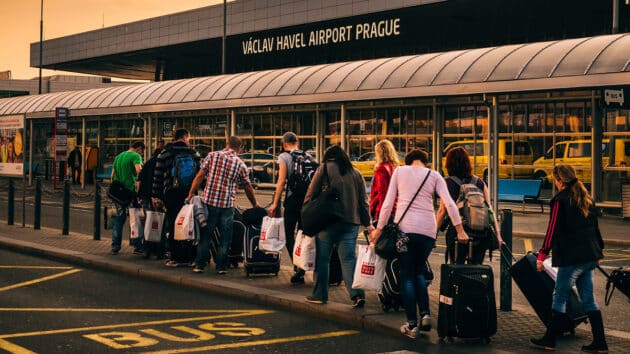Artificial intelligence (AI) advancements promise to simplify operations in industries such as healthcare, human resources, and commerce by gathering massive quantities of data to better analyze risk, enhance forecasts, and execute transactions far quicker than humans can.
The same is valid for border control and passport control, where authorities and technology enthusiasts tout the promise of AI to more efficiently and, in some situations, more safely safeguard international boundaries.
The use of artificial intelligence in border areas

Officials have been fast to implement “smart borders” AI technologies into their procedures in recent years, signaling a possible tipping point for governments’ capacity to monitor their borders, particularly in the United States and the European Union.
Border-aware AI systems can take many forms, including algorithms created to assess travelers’ subtle and almost unnoticeable emotional expressions, biometric authentication, face recognition, and scanning software capable of distinguishing humans from wild animals in distant border areas.
Several of the programs are based on monitoring technologies that have been in some form or another for decades but have grown increasingly automated to the point that computers, rather than humans, reach early judgments about potential dangers and how governments should respond. Artificial intelligence has the potential to reinforce this insight by making instruments more powerful and capable of processing and interpreting more data than previously.
However, the quick deployment of these innovations, which has frequently been faster than the legislative and regulatory frameworks controlling their use, has created concerns about privacy and increased government monitoring not only of migrants and tourists but of the entire population.
For instance, face recognition technology has been utilized in airports and other border regions across the world. In 2018, Dubai International Airport began testing a “smart tunnel,” which employs an 80-camera system to scan visitors’ faces and irises, permitting pre-checked passengers to authenticate their identification in seconds without showing passports or other documentation.
Since then, the system has grown to include more than 120 smart gates located across the airport. Similar technology has been adopted at numerous airports in the United States and abroad, providing travelers with an alternative to the cumbersome security processes that have come to define contemporary international travel.
However, these technologies create issues, particularly regarding individual privacy. Critics warn of the dangers of technology spreading as systems designed for border areas gradually infiltrate the mainstream culture, where they may be used to spy on the whole populace.
China, for instance, has received increasing scrutiny for its surveillance and monitoring systems, which are expected to outlive the epidemic as part of its zero-COVID policy against the coronavirus. In general, it was unclear at times whether visitors agreed to disclose biometrics and other data to government authorities, or what rights people had in their still-evolving connection with AI technology.
In contemporary practice, AI systems are typically deployed in addition to border guards, enabling fewer people to monitor more territory and screen more migrants and other visitors in less time and for less money than would be otherwise feasible.
However, the system has improved and been built for additional characteristics, such as current attempts to algorithmically detect tourists who are infected with the novel coronavirus that causes COVID-19 yet have no symptoms.
Understanding how AI is applied at international borders will become more crucial as these advances progress since it affects both residents and travelers. We’ll then take a closer look at one particular use of artificial intelligence (AI) systems for passport control, with an emphasis on the detection tools that make up the so-called “smart border.”
Recommended for you: Data Science vs. Artificial Intelligence – What are the Differences?
AI technologies in passport control

Artificial intelligence (AI)-based solutions enhance the effectiveness of passport control through the integrated Smart ID Engine software.
Smart ID Engine is a complete AI-based solution for automatic ID scanning, document verification, and data internal consistency of over 1810 varieties of IDs from 210 issuers worldwide, which is put at electronic gates, and passport control delays may become a distant memory.
For contactless border checks on international flights, Sapsan computerized passport control posts at Sheremetyevo International Airport SVO (Moscow, Russia) were outfitted with Smart Engines artificial intelligence software. By decreasing manual security and identity checks, an automation process may considerably improve border guard productivity. Advanced artificial intelligence-powered software closes security vulnerabilities and assures total security for both travelers and airport border protection systems.
ASPK “Sapsan” is a high-tech technology and hardware complex built with Russian and local components. The system is intended to perform completely automatic passport checks of travelers crossing the Russian Federation’s state border, including matching biometric data recorded in the passport with the owner’s biometric information.
Passport information is scanned using OCR technology, allowing you to optimize the document verification procedure. Like a simpler AI processing photo (background removal, correction, etc.) for online documents in different services.
Both passengers and airport border control systems are fully safe when using advanced AI-based technologies. This technology assists border officers in achieving severe regulatory requirements while adhering to both national and international security protocols (GDPR, CCPA, and others). The SDK does not save or transport data or pictures to Smart Engines or third-party companies for processing. Processing takes place in the e-gates’ local RAM and does not involve Internet connectivity.
GazIntekh created the Sapsan electronic passport control system, which includes a text recognition feature powered by Smart Engines. At the moment, Terminal C has 20 Sapsan computerized passport control booths, 10 for departure and 10 for arrival. Residents of the Russian Federation aged 18 and above possessing foreign passports from the 75th series and higher with biometric tagging are eligible to use them.
Sapsan, which uses cutting-edge biometric identification algorithms and high-tech gear, accelerates the passenger control process, making it easier and more intelligible for residents. This, in turn, drastically decreases waiting time at the border, providing excellent security.
“With rising worldwide demand for border control, time is more critical than ever before: no one can risk missing a flight, yet everyone wants to pass through border checks securely,” as nicely explained by the CEO of PhotoBooth.online.
Passenger satisfaction has grown dramatically, according to SVO authorities, since the installation of computerized gates with AI-driven software. At the border checks, throughput has more than quadrupled.
Passport digital gates will also be extended for use at airports, as anticipated, in an effort to significantly increase border guard service efficiency by minimizing manual recognition and security checks.
Looking bigger: leveraging multivariate data and AI-based selectivity models to strengthen law enforcement

The amount and output of data are increasing exponentially as a result of global digitization, which is also causing a rise in demand for data across the board. A never-ending stream of information made up of untold bytes is produced by billions of public and private entities.
The data revolution has never-before-seen benefits and problems for Customs. They need to simulate AI fraud using next-generation multi-dimensional data ecosystems in order to understand the exceptional value of this new reality. They will be able to fully benefit from so-called digital verification as a result.
A fundamental component of enforcement capabilities is increasing selectivity, and as such, it should undergo the same amount of modernization and innovation as other aspects of customs procedures and processes. However, the selection is firmly rooted in the distant past, realistically speaking.
Predictive analytics employs mathematical modeling techniques to comprehend the future by providing potential outcomes in the ideal situation. However, the caliber and volume of data used determine how well predictions can be made and fraud may be detected. Models get distorted when there is a lack of reliable data.
From a practical standpoint, the selectivity paradox is as follows:
- The selectivity requirements are limited to prior knowledge about a single measurable event since the predictive analytic models now in use to enable selectivity are mostly constructed from flat, one-dimensional data.
- Therefore, the simulation is primarily based on incomplete data (internal and historical transactional data).
- When analytic models remain “static,” the underlying data changes and adapts over time, but the models do not take into account the accompanying changes in the data. This results in “data skew,” which is a problem.
Skewed models usually provide unfavorable results for Customs: either a high number of false positives or a low level of fraud detection.
It is significant to note that information about transactions and/or seizures outside the nation may occasionally be made available through domestic or private data-sharing agreements; however, this is more of an exception than a rule and typically isn’t sufficient to tilt the scales.
You may also like: 17 Cool Tips for Writing a Cybersecurity Policy that Doesn’t Suck.
Conclusion

AI systems are now utilized as a supplement to border guards, allowing fewer humans to oversee more area and scan more migrants and other passengers in less period and for less cost than would otherwise be feasible.
However, the system has progressed and been adapted to accommodate additional traits, such as recent attempts to algorithmically detect asymptomatic passengers infected with the novel coronavirus that causes COVID-19.
Understanding how AI is employed at international borders will become increasingly crucial as these technologies evolve, as its use affects not just passengers but also inhabitants.





